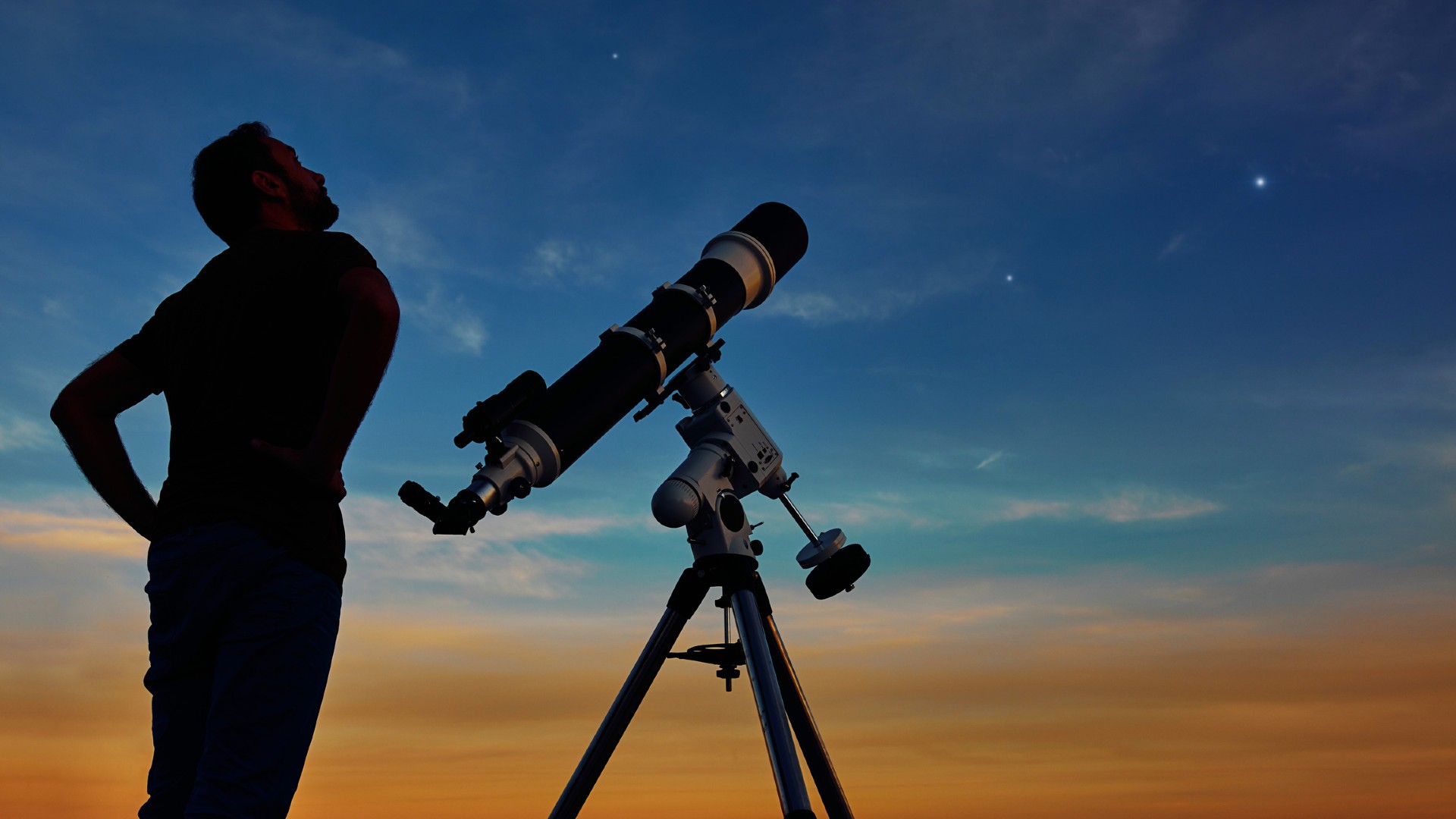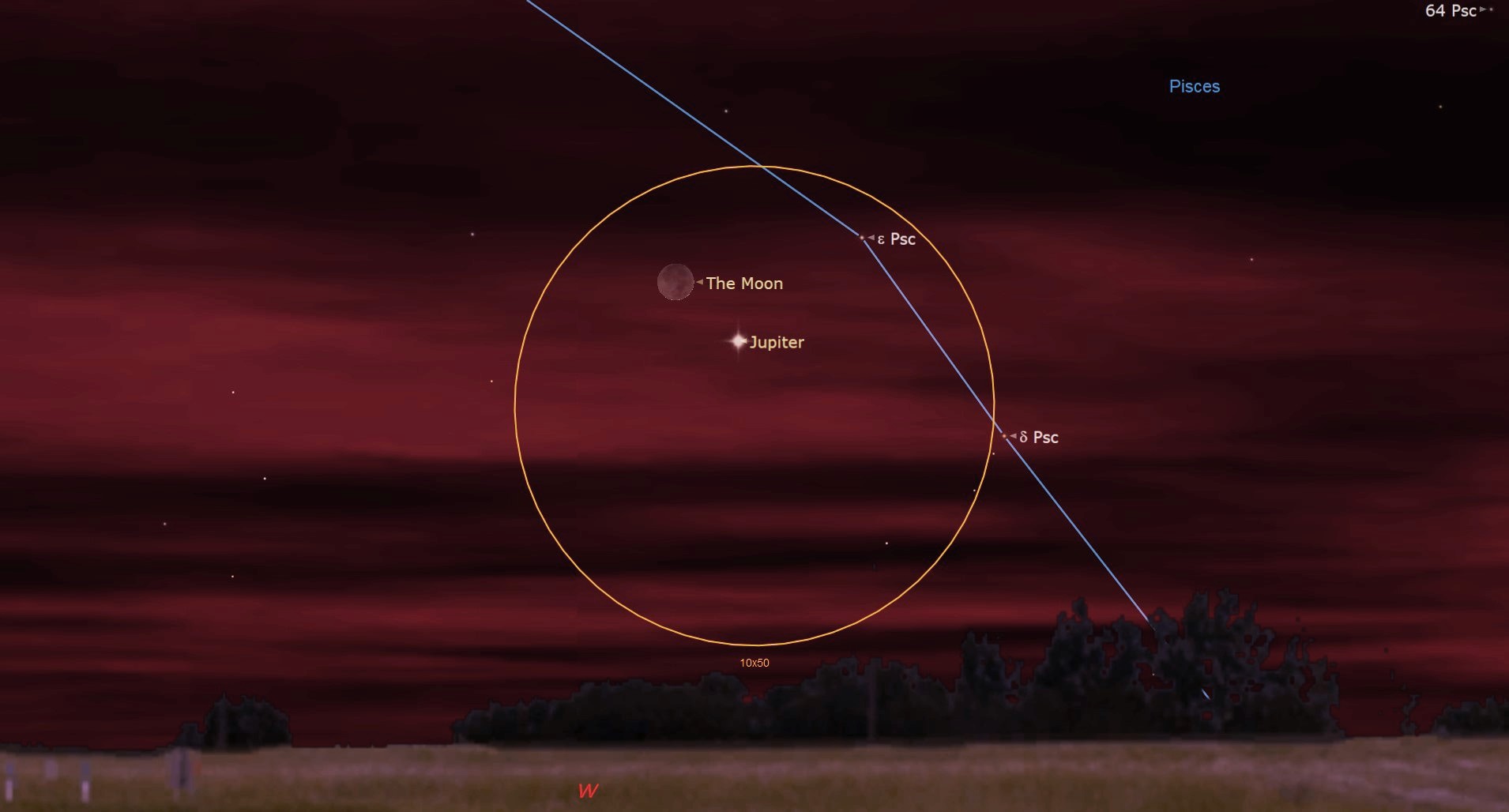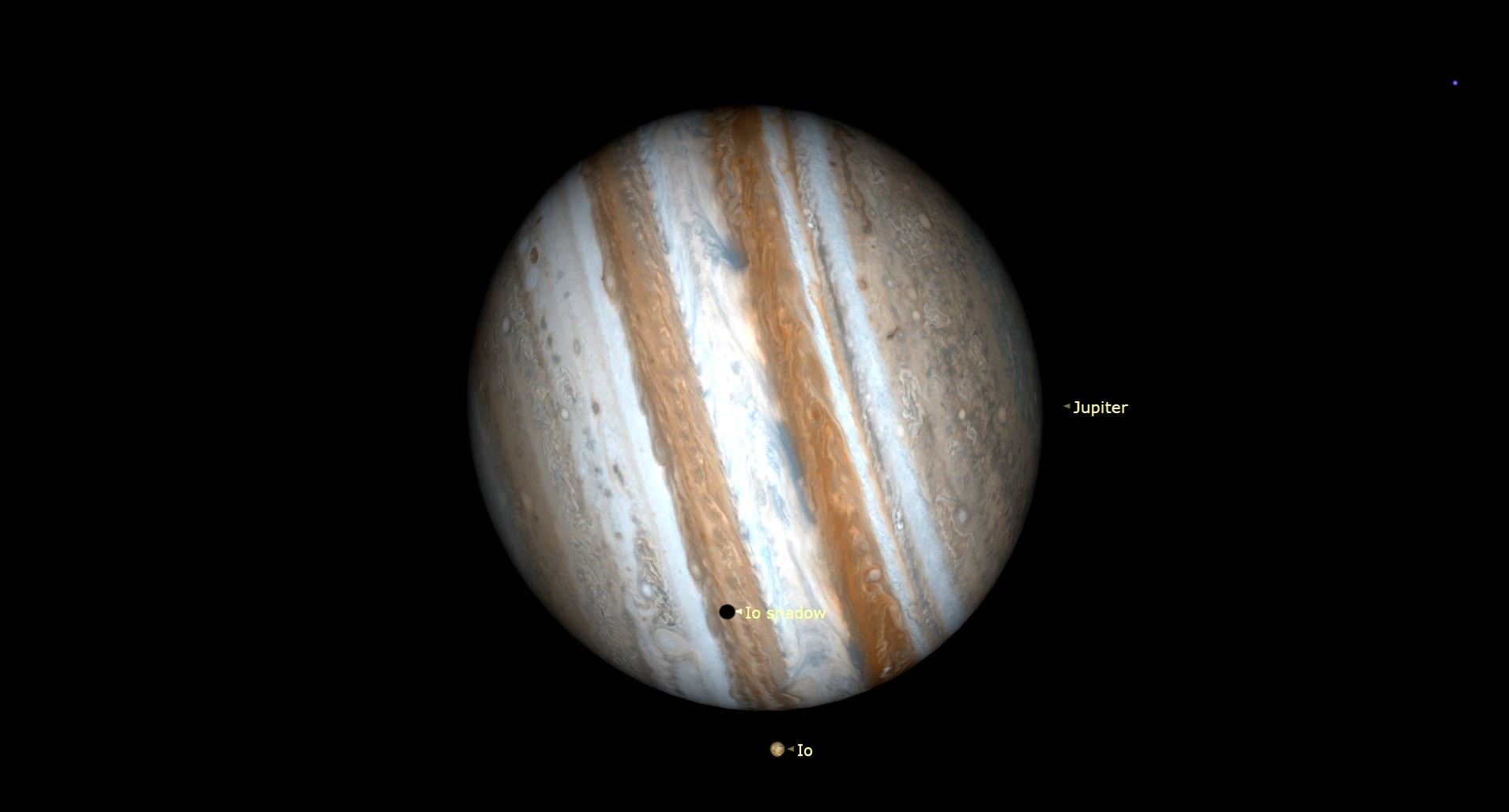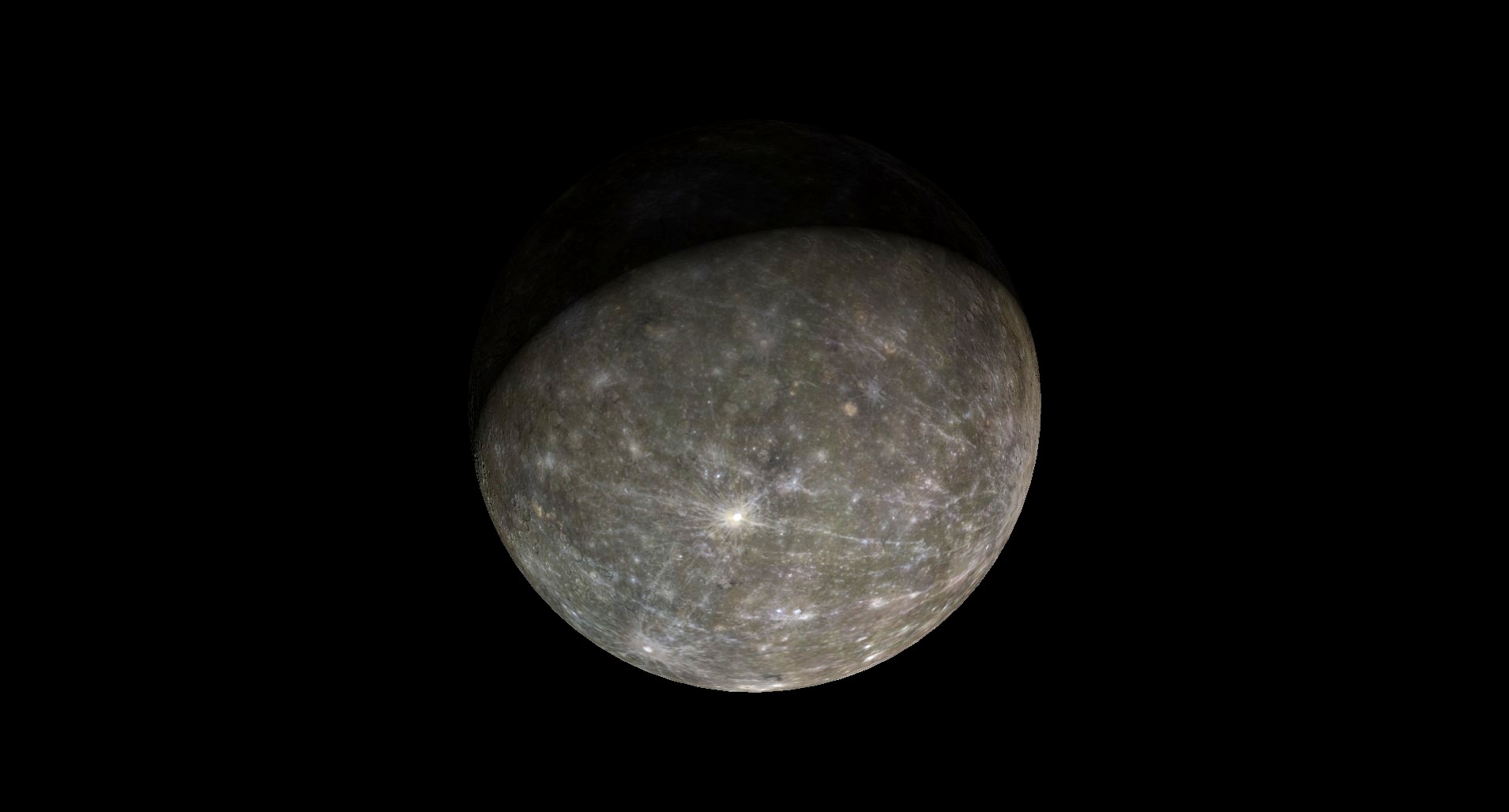
Jupiter has put on an admirable show this month of March, in spite of the fact that it is now rapidly relinquishing its many months of dominance in the evening sky. It teamed with Venus at the start of the month, making for a stunning sight in the western evening twilight. But the giant of the solar system still has two more appointments on its docket to keep during the time frame running from March 22 to 27.
Jupiter will be lost in the sun's afterglow by month's end, but on the 22 it still will be setting roughly 70 minutes after the sun. And on that evening, it will be visible to the lower right of a delicately thin waxing crescent moon.
Five days later, the moon will be long gone, but now the smallest planet, Mercury, burning much brighter than usual, will appear next to the giant of the solar system. Both, however, will be tucked deep in the bright twilight, making for a very challenging observation.
Related: Night sky, March 2023: What you can see tonight [maps]
March 22: Jupiter sides with a "young" moon

Looking for a telescope to see the planets in the night sky? We recommend the Celestron Astro Fi 102 as the top pick in our best beginner's telescope guide.
"New moon," as used by astronomers, means the instant when the moon is at the same ecliptic longitude as the sun. This instant marks the starting point of a new lunar cycle, averaging 29.53 days; a lunation or synodic month. The word is derived from the Greek synodikos meaning "meeting" (for at new moon, the moon "meets the sun").
But in popular parlance "new moon" tends to mean the moon as it becomes narrowly visible on the next few evenings. For distinctions some call this the "young" moon; and, by analogy, the moon is deemed "old" when it is seen on the last few mornings of the cycle, just before the moon dies and is reborn at its "New" moment. The "age" of the moon is the time measured from the instant of new moon (as if that is the "birth" of the moon).
Many cultures have calendars that are based on the movement of the moon. For instance, Ramadan, the 9th month of the Muslim calendar and the holy month of fasting, begins with the first appearance of the moon on Wednesday evening, March 22.
Get the Space.com Newsletter
Breaking space news, the latest updates on rocket launches, skywatching events and more!
A half hour after local sunset, search low above the western horizon to catch a glimpse of this hairline crescent that will hang a little over one degree to the upper left of Jupiter. The sliver of the moon will be only 2 percent illuminated and depending on what part of the country you're located, only 30 to 33 hours from its new phase.
At this particular moment we can hardly call this a crescent moon. Rather, it will appear more like an exceedingly thin filament of light, encompassing less than a 180-degree arc, and only somewhat perceptible against the backdrop of the bright twilight sky. Jupiter, appearing as a sharp, bright dot might be easier to see. Binoculars will be most beneficial in your capturing a view of this rendezvous.
Read more: March 2023 new moon kicks off Ramadan with Orion high in the sky

March 27: The biggest planet rendezvous with the smallest
On Monday evening (March 27), step outside about 20 minutes after sunset and look due west. Make sure that you have a clear and unobstructed horizon with no tall trees or buildings to block your view. If the weather is very clear that evening, what you will see is a meeting between the smallest and biggest planets in our solar system: Mercury and Jupiter.
As I just alluded to, both of these worlds will be way down low ... troublesomely low, only about 5 degrees above the horizon in a bright twilight sky. That's roughly the equivalent of the width of half of your clenched fist held at arm's length.
And although they both will be shining brilliantly — Mercury at magnitude -1.4 and Jupiter at magnitude -2.1 — both may be very difficult to see through the bright evening twilight. Your best chance to pick them up is initially to sweep low along the western horizon with good binoculars; then seek them out with your naked eye. Mercury will be to the right of brighter Jupiter. On this particular evening they will be separated by just 1.3 degrees; they'll appear separated by just over one-finger width at arm's length.
Read more: See Jupiter and Venus dance across the twilight sky in this amazing photo collage

In reality, nowhere near each other
But looks are deceiving.
The two planets will merely happen to be along our same line of sight. Mercury on March 27 is 114.6 million miles (184.4 million km) from Earth, or put another way, 10.3 light-minutes away, while Jupiter is nearly 5-times farther: 550.9 million miles (886.5 million km) from Earth, or 49 light minutes away.
There are other contrasts as well. Jupiter shines with a silvery glow, while Mercury tends to appear slightly orange-red in coloration. Of course, the biggest contrast is size. Jupiter is the solar system's largest planet with a diameter of 88,846 miles (142,984 km) compared to puny Mercury at 3,031 miles (4,878 km). And indeed, even though Mercury is nearly five times closer to us than Jupiter, in a telescope Jupiter's disk appears almost six times larger.
Twinkle twinkle little planet
In fact, because of its much smaller apparent size and closeness to the horizon, Mercury might even appear to twinkle a bit compared to Jupiter. Twinkling is an effect caused by the slight heat waves that are constantly rippling through Earth's atmosphere, chiefly just a few miles from your eyes. Stars are mere pinpoints of light and are subject to this twinkling effect all the time. Planets appear larger than a pinpoint and so they average out to a steady glow. Still, Mercury's small size plus its proximity to the horizon where the atmosphere is always quite unstable may impart a bit of twinkling to it.
If you're hoping to catch a close-up look at Mercury, Jupiter or both, guide for the best telescopes will help. If you want to catch the two celestial objects together, our guide to the best binoculars is a great place to start.
If you're looking to take your own photos of the night sky, check out our guides on how to photograph the moon and the best cameras for astrophotography and best lenses for astrophotography.

Going in opposite directions
To this get together of two contrasting worlds, perhaps we can paraphrase that famous idiom of Henry Wadsworth Longfellow. Jupiter is heading in the direction of the sun; within a few days it will be rendered invisible by the solar glare. Mercury on the other hand, has been out of sight all through March having been too near the sun to be seen. But now it is emerging into view in the evening sky. But this week they are:
"Two planets that pass in the twilight."
Good luck and clear skies!
Joe Rao serves as an instructor and guest lecturer at New York's Hayden Planetarium. He writes about astronomy for Natural History magazine, the Farmers' Almanac and other publications. Follow us on Twitter @Spacedotcom and on Facebook.
Join our Space Forums to keep talking space on the latest missions, night sky and more! And if you have a news tip, correction or comment, let us know at: community@space.com.

Joe Rao is Space.com's skywatching columnist, as well as a veteran meteorologist and eclipse chaser who also serves as an instructor and guest lecturer at New York's Hayden Planetarium. He writes about astronomy for Natural History magazine, Sky & Telescope and other publications. Joe is an 8-time Emmy-nominated meteorologist who served the Putnam Valley region of New York for over 21 years. You can find him on Twitter and YouTube tracking lunar and solar eclipses, meteor showers and more. To find out Joe's latest project, visit him on Twitter.









